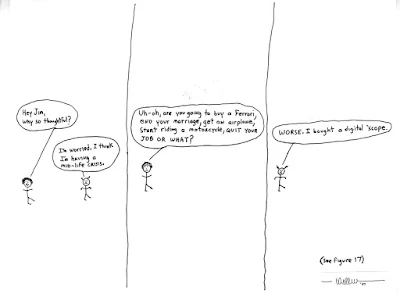From the r2pro yahoo mailing list:
Hi All,
Some interesting posts lately, with notes or links on "to build or not to build," new H-Mode mixers for HF, and front-end filter intermod. A recurring thought is that I do lots of projects and each of my projects is a separate design, starting with a bunch of sketches. I didn't invent this approach--think of DaVinci, for example. I don't count my sketches, but probably make ten or twenty for every one that progresses to a design of something that would actually work, and maybe only one in ten of those makes it to prototype hardware. I do a lot of sketches--hundreds for every working radio, and maybe finish a dozen working radios for every one that I write up, either as a good or bad example.
But my sketches all seem to have something in common--they are sketched to do one particular thing well. They tend to be for one band, one mode, and are designed with particular power supply limitations and the antenna I'm going to use known ahead of time. They often include at least one but no more than two experiments--something new and risky enough that it might not work. More than two experiments almost always end up interacting in some unpredicted and dysfunctional way, so I try to limit risky new brilliant ideas to no more than one or two per project. The key is to do lots of projects, and lots and lots of sketches.
I don't normally operate in brutally strong signal environments, so my dynamic range/IIP requirement is already satisfied with techniques that have been standard since all the excellent work by Wes Hayward, Ulrich Rohde et al. in the 1970s and 80s. The problem has been solved, like the appropriate number of wheels on a bicycle. Sure, there are extreme enthusiasts who limit themselves to one wheel and play the bagpipes while riding... My risky new front-end sketches are often aimed at meeting those acceptable prior benchmarks in some clever and different way, rather than adding a few dB on top of already good dynamic range. ...Yes, that works well, but I think I'll try doing it this way instead...
Similarly, my input filters aren't the limitation on my intermod performance. PIM is a big deal in some contexts, and the latest research is fascinating. Do a google search on Passive Intermodulation PIM to get started on some interesting reading on that topic.
Regarding the question "to build or not to build," I believe that comes down to something very basic: are you a builder? If yes, then you have no choice. I can look around my radio room and see a hundred different radios that I've designed and built, and a few more in progress. If you do the math in my first paragraph above, that's around ten thousand sketches. My lab notebooks have 200 pages, and I've filled up 140 notebooks since 1975, so that figure is reasonable. It's just something I do, like some guys go fishing. Sketches don't take long. I can do two or three on a half-hour train ride on the way to work. A complete design to where I start cutting metal and gathering parts might be a few hours a day for a week. Then another month, maybe a few hours at a time on weekends to finish up a nice project. There have been more than 2000 weekends since 1975, so even 100 completed radios has left most of my time for other things.
I am very close to folks who are the same way writing code. They've been filling notebooks with it since grade school, and doing Software Defined Radio since long before they ever encountered the abbreviation "SDR."
If your personal sketches are full of code or CMOS logic, I expect your radios to look and work differently from mine. If you operate 6m weak signal modes a half mile from a hilltop kilowatt contest station, you have a fascinating set of dynamic range problems to solve. Years ago, my 11 year old daughter and her best friend thought the absolute best radio ever was the morse code transmitter that Wes Hayward and Bob Culter worked across town using a couple pieces of metal stuck in a lemon for power. Neither Wes nor Bob would embrace the limitations of that rig for all their amateur radio contacts, but at the time it was a really cool project.
These are just some rambling, Saturday night thoughts, but if you read between the lines you can maybe understand a bit more of why I tend to do things some interesting way that might not apply to your particular application. One time I accidentally left one of my notebooks at a close friend's house, and he took the liberty of making copies of a bunch of the pages. I'm not sure it did him any good, but he sure found it entertaining. There is great freedom in sketching things that have a small probability of actually having to work well in practice.
Enjoy the experiments, and if you have self-identified as a builder, as have many of the denizens of this site, then enjoy making sketches, developing designs, and taking risks that either pay off or end up as learning experiences.
Best Regards,
Rick




















































